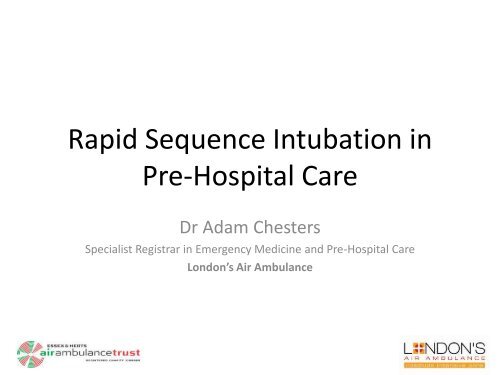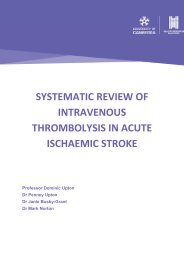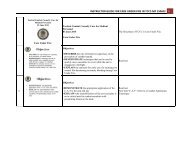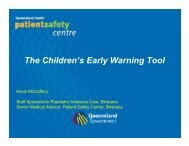RSI at LAA
RSI at LAA
RSI at LAA
You also want an ePaper? Increase the reach of your titles
YUMPU automatically turns print PDFs into web optimized ePapers that Google loves.
Rapid Sequence Intub<strong>at</strong>ion in<br />
Pre-Hospital Care<br />
Dr Adam Chesters<br />
Specialist Registrar in Emergency Medicine and Pre-Hospital Care<br />
London’s Air Ambulance
CV<br />
• University of Leicester Medical School<br />
• Emergency Medicine, Anaesthetics, Critical Care<br />
John Radcliffe Hospital<br />
Noble’s Hospital<br />
Northern General Hospital<br />
West Suffolk Hospital<br />
Addenbrooke’s Hospital<br />
St Mary’s Hospital<br />
• Pre-Hospital and Retrieval<br />
Essex and Herts Air Ambulance<br />
East Anglian Air Ambulance<br />
Children’s Acute Transport Service<br />
London’s Air Ambulance<br />
Oxford<br />
Isle of Man<br />
Sheffield<br />
Bury St Edmunds<br />
Cambridge<br />
London
For the purposes of this talk...<br />
• Accept th<strong>at</strong> pre-hospital <strong>RSI</strong> is beneficial to<br />
certain seriously injured p<strong>at</strong>ients<br />
• Think about robust systems and safe techniques
Things to think about...<br />
• London’s Air Ambulance<br />
– Description of the process<br />
– L<strong>at</strong>est st<strong>at</strong>istics<br />
• Pre-hospital rapid sequence intub<strong>at</strong>ion<br />
– Who benefits?<br />
– Do we need drugs?<br />
– Do we need doctors?<br />
– Do we need a system?
London’s Air Ambulance<br />
Philosophy for pre-hospital intub<strong>at</strong>ion:<br />
1. None of our p<strong>at</strong>ients should have to wait to<br />
get an anaesthetic if they need one<br />
2. Technique must be safe and reproducible<br />
3. The first <strong>at</strong>tempt <strong>at</strong> intub<strong>at</strong>ion must have the<br />
maximum chance of success
London’s Air Ambulance<br />
• 25,000 missions since launch in 1989<br />
• 20-30% of all p<strong>at</strong>ients seen get <strong>RSI</strong><br />
• Experience of over 6000 pre-hospital <strong>RSI</strong>s
London’s Air Ambulance<br />
• Simple algorithm for <strong>RSI</strong>:<br />
– <strong>RSI</strong> required?<br />
– If yes, perform standard <strong>RSI</strong> technique<br />
– Fail to intub<strong>at</strong>e after failed intub<strong>at</strong>ion drills?<br />
• Surgical airway or supraglottic device<br />
EXACTLY THE SAME EVERY TIME
The Process<br />
1. Decision<br />
2. Form a team<br />
3. Maximum pre-oxygen<strong>at</strong>ion<br />
4. Kit dump and equipment prepar<strong>at</strong>ion<br />
5. Check list<br />
6. Anaesthetic drugs<br />
7. Intub<strong>at</strong>ion<br />
8. Confirm<strong>at</strong>ion<br />
9. Maintenance of anaesthesia<br />
10.Journey to hospital<br />
11.Handover to hospital team
1. Decision<br />
Simple criteria:<br />
1. Unconscious<br />
2. Agit<strong>at</strong>ed head injuries<br />
3. Airway compromise<br />
4. Ventil<strong>at</strong>ory failure<br />
5. Anticip<strong>at</strong>ed clinical course<br />
Traum<strong>at</strong>ic brain injury<br />
Pre-hospital mortality<br />
In-hospital mortality<br />
6. Humanitarian reasons
2. Form a team
3. Maximum Pre-oxygen<strong>at</strong>ion
4. ‘Kit Dump’
Move the p<strong>at</strong>ient to the kit...<br />
• Cre<strong>at</strong>e a working space to deliver anaesthetic<br />
• 360 access to p<strong>at</strong>ient<br />
• Shaded from sunlight<br />
• Lit <strong>at</strong> night<br />
• Quiet (engines, phones, radios turned off)<br />
• Paramedic lays out equipment while doctor<br />
finishes p<strong>at</strong>ient assessment and briefs team<br />
• Near to ambulance for loading
5. <strong>RSI</strong> Checklist<br />
•Allows period of oxygen<strong>at</strong>ion<br />
•Equipment present<br />
•Equipment working<br />
•Optimise first <strong>at</strong>tempt<br />
•Back up plan understood
6. Anaesthetic drugs
Choice of drugs<br />
• Etomid<strong>at</strong>e<br />
• Suxamethonium<br />
• Pancuronium<br />
• Morphine and Midazolam<br />
Pick suitable drugs for the service and make<br />
sure all personnel know them in detail<br />
EXACTLY THE SAME EVERY TIME
7. Intub<strong>at</strong>ion
Maximising chance of success<br />
• Prepar<strong>at</strong>ion<br />
– Good team work and using a check list<br />
• Positioning<br />
– 360 access to the p<strong>at</strong>ient<br />
– P<strong>at</strong>ient <strong>at</strong> waist height on ambulance trolley<br />
– Oper<strong>at</strong>or kneeling <strong>at</strong> head of p<strong>at</strong>ient<br />
– Cervical spine collar removed<br />
• Help<br />
– Bougie every time<br />
– Skilled assistant<br />
– Well rehearsed failed intub<strong>at</strong>ion drill
8. Confirm<strong>at</strong>ion
9. Maintain anaesthesia and monitor
10. Load and convey
11. Handover to the hospital
<strong>RSI</strong> and the ‘anaesthetic package’<br />
• Full monitoring<br />
• Maximum pre-oxygen<strong>at</strong>ion<br />
– adjuncts and sed<strong>at</strong>ion<br />
• Drugs to induce anaesthesia and paralyse<br />
• Intub<strong>at</strong>ion and confirm<strong>at</strong>ion of placement<br />
• A failed airway drill<br />
• Maintenance of anaesthesia<br />
• Appropri<strong>at</strong>e ventil<strong>at</strong>ion str<strong>at</strong>egy
Failure to intub<strong>at</strong>e<br />
• 30 second drills<br />
– Small changes th<strong>at</strong> may make a huge difference<br />
– Can be read out as a check list<br />
• Decision:<br />
– Surgical airway<br />
– Supraglottic device (iGel)
Roles in the team?<br />
• HEMS Doctors<br />
– Intub<strong>at</strong>ion<br />
• HEMS Paramedics<br />
– Very unusual for paramedic to intub<strong>at</strong>e<br />
– Highly skilled assistant<br />
• Equipment laid out and immedi<strong>at</strong>ely to hand<br />
• Passes tube over bougie and <strong>at</strong>taches anaesthetic circuit<br />
• Failed intub<strong>at</strong>ion drills done together<br />
• Support, ideas, reminders<br />
• Retrieves equipment to ensure quick departure
Harris T, Lockey D<br />
Emergency Medicine Journal<br />
2010<br />
January 2006 – May 2007
Snapshot of a different system<br />
• San Diego Paramedic <strong>RSI</strong> Trial (1998 – 2002):<br />
– Paramedic-performed <strong>RSI</strong><br />
– Head injury with GCS
Davis et al. J Trauma. 2002
Dunford et al.<br />
Annals of Emergency Medicine.<br />
42(6). 2003<br />
54 p<strong>at</strong>ients:<br />
31 des<strong>at</strong>ur<strong>at</strong>ed to
San Diego <strong>RSI</strong> Trial<br />
• New system introduced<br />
• Single Paramedic<br />
• 8 hours training<br />
– <strong>RSI</strong><br />
– Medic<strong>at</strong>ions<br />
– Failed airway device<br />
– GCS scoring<br />
– Ventil<strong>at</strong>ion str<strong>at</strong>egies<br />
• ± Very low dose Midazolam<br />
• Cricoid pressure for all<br />
• 60 seconds pre-oxygen<strong>at</strong>ion<br />
• No ETCO2 monitoring<br />
– Inadvertent hyperventil<strong>at</strong>ion<br />
– ‘standard’ settings for all<br />
London’s Air Ambulance<br />
• >6000 <strong>RSI</strong>s completed<br />
• Doctor-Paramedic team<br />
• Senior doctors<br />
– At least 6 months anaesthetics<br />
– Consultants or senior registrars<br />
– Ongoing training<br />
– 30-40 <strong>RSI</strong>s over 6 months<br />
– Constant review of outcomes<br />
• Induction dose Etomid<strong>at</strong>e<br />
• Low threshold for release<br />
• Maximum pre-oxygen<strong>at</strong>ion<br />
• Full monitoring<br />
– ETCO2 key end-point<br />
– Ventil<strong>at</strong>ion titr<strong>at</strong>ed
Robust systems and safe techniques<br />
• London’s Air Ambulance<br />
– Description of the process<br />
– L<strong>at</strong>est st<strong>at</strong>istics<br />
• Pre-hospital rapid sequence intub<strong>at</strong>ion<br />
– Who benefits?<br />
– Do we need drugs?<br />
– Do we need doctors?<br />
– Do we need a system?





